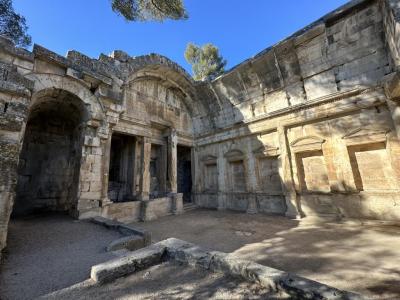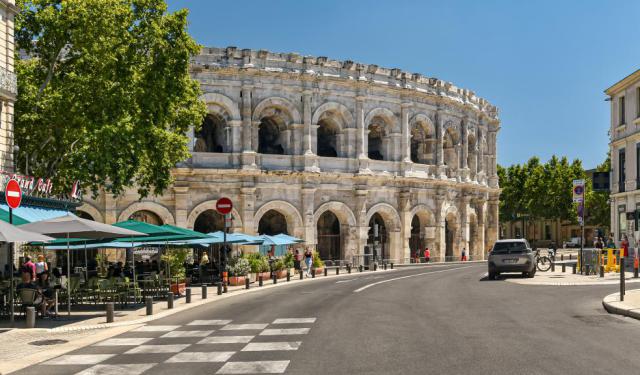
Temple of Diana, Nimes
The Temple of Diana, a remarkable 1st-century ancient Roman structure in Nîmes, stands as a testament to the architectural and historical richness of the region. This structure, known as the Temple of Diana, was built during the reign of Augustus and is located near the gushing spring of "La Fontaine." It is closely associated with an Augusteum, a sanctuary dedicated to the veneration of the emperor and his family, with a central focus on a nymphaeum.
Although traditionally referred to as the Temple of Diana, its basilica-like floor plan raises questions about its classification as a temple, and there is a lack of archaeological or literary evidence to support its dedication to Diana. Some suggest that this building may have served as a library instead. During the 2nd century, its façade was reconstructed, and in medieval times, it found use as a monastery, which contributed to its preservation over the years.
In 1745, during the creation of the La Fontaine garden, the Temple of Diana was excavated, revealing its architectural and historical significance. The building, with its unusual roof construction, features several intricately designed thick barrel-vaulted rooms, constructed with meticulously cut ashlars that support an upper floor. Partially carved into the side of Mount Cavalier, the building was originally accompanied by annexes. The main facade is characterized by three grand arches, adding to its grandeur.
The remains of the Temple of Diana mainly consist of a vaulted hall measuring 14.5 meters by 9.5 meters, flanked by two staircases that led to adjacent, no longer existing, structures. The north side wall is adorned with a series of five rectangular niches, each surmounted by alternating triangular and semi-circular pediments. Columns of the composite order stood between each niche, enhancing the architectural details. Additionally, three other rooms showcase ceilings adorned with intricately carved coffered designs.
One remarkable archaeological discovery during the 1745 excavations was the opus sectile floor, composed of precious marble pieces of various colors arranged within a mortar backing. This extraordinary historical site was not only depicted in paintings by artists like Hubert Robert and other 18th-century painters but also recognized as a monument historique in 1840, highlighting its cultural and architectural significance. Today, the Temple of Diana can be visited from the Jardins de la Fontaine, providing an opportunity for visitors to immerse themselves in its historical and architectural grandeur.
Opened 24 hours.
Although traditionally referred to as the Temple of Diana, its basilica-like floor plan raises questions about its classification as a temple, and there is a lack of archaeological or literary evidence to support its dedication to Diana. Some suggest that this building may have served as a library instead. During the 2nd century, its façade was reconstructed, and in medieval times, it found use as a monastery, which contributed to its preservation over the years.
In 1745, during the creation of the La Fontaine garden, the Temple of Diana was excavated, revealing its architectural and historical significance. The building, with its unusual roof construction, features several intricately designed thick barrel-vaulted rooms, constructed with meticulously cut ashlars that support an upper floor. Partially carved into the side of Mount Cavalier, the building was originally accompanied by annexes. The main facade is characterized by three grand arches, adding to its grandeur.
The remains of the Temple of Diana mainly consist of a vaulted hall measuring 14.5 meters by 9.5 meters, flanked by two staircases that led to adjacent, no longer existing, structures. The north side wall is adorned with a series of five rectangular niches, each surmounted by alternating triangular and semi-circular pediments. Columns of the composite order stood between each niche, enhancing the architectural details. Additionally, three other rooms showcase ceilings adorned with intricately carved coffered designs.
One remarkable archaeological discovery during the 1745 excavations was the opus sectile floor, composed of precious marble pieces of various colors arranged within a mortar backing. This extraordinary historical site was not only depicted in paintings by artists like Hubert Robert and other 18th-century painters but also recognized as a monument historique in 1840, highlighting its cultural and architectural significance. Today, the Temple of Diana can be visited from the Jardins de la Fontaine, providing an opportunity for visitors to immerse themselves in its historical and architectural grandeur.
Opened 24 hours.
Want to visit this sight? Check out these Self-Guided Walking Tours in Nimes. Alternatively, you can download the mobile app "GPSmyCity: Walks in 1K+ Cities" from Apple App Store or Google Play Store. The app turns your mobile device to a personal tour guide and it works offline, so no data plan is needed when traveling abroad.
Temple of Diana on Map
Sight Name: Temple of Diana
Sight Location: Nimes, France (See walking tours in Nimes)
Sight Type: Attraction/Landmark
Guide(s) Containing This Sight:
Sight Location: Nimes, France (See walking tours in Nimes)
Sight Type: Attraction/Landmark
Guide(s) Containing This Sight:
Walking Tours in Nimes, France
Create Your Own Walk in Nimes
Creating your own self-guided walk in Nimes is easy and fun. Choose the city attractions that you want to see and a walk route map will be created just for you. You can even set your hotel as the start point of the walk.
Ancient Roman Ruins in Nimes
Nicknamed “the French Rome,” the southern French town of Nimes is indeed the most Roman city outside of Italy. In large part, this is due to a wealth of architectural monuments that have remained here since the Roman era. Some ruined and some well-preserved, they offer a captivating glimpse into the ancient history stretching back to the early days of Roman expansion.
A true testament to... view more
Tour Duration: 2 Hour(s)
Travel Distance: 3.7 Km or 2.3 Miles
A true testament to... view more
Tour Duration: 2 Hour(s)
Travel Distance: 3.7 Km or 2.3 Miles
Nimes Introduction Walking Tour
Dubbed the most Roman city outside Italy, Nimes, a small city in Southern France, is steeped in history that harks back to the days of the mighty Roman Empire.
The name itself holds clues to the city's origin, reflecting Celtic roots and connection with the local god, Nemausus, associated with a healing spring.
The hill of Mount Cavalier, once an oppidum, served as the birthplace of... view more
Tour Duration: 1 Hour(s)
Travel Distance: 1.8 Km or 1.1 Miles
The name itself holds clues to the city's origin, reflecting Celtic roots and connection with the local god, Nemausus, associated with a healing spring.
The hill of Mount Cavalier, once an oppidum, served as the birthplace of... view more
Tour Duration: 1 Hour(s)
Travel Distance: 1.8 Km or 1.1 Miles


